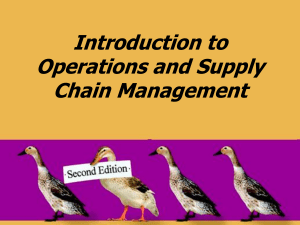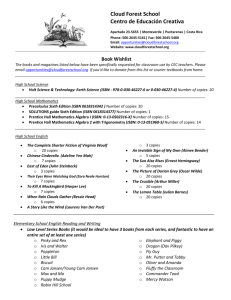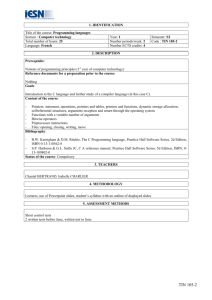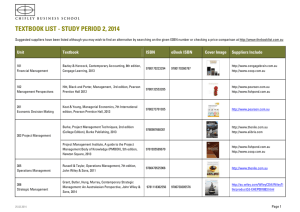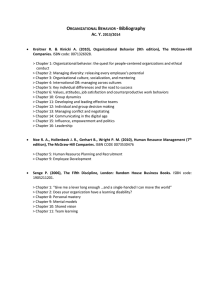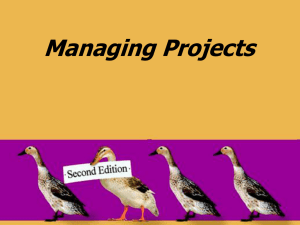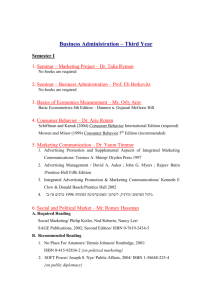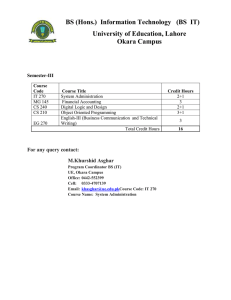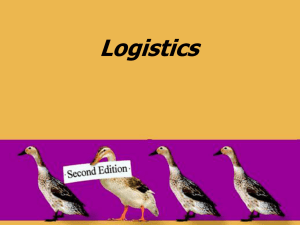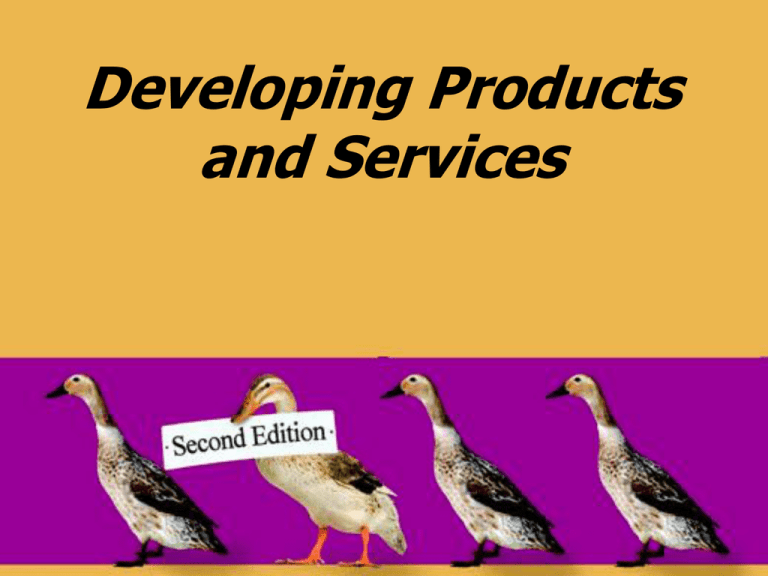
Developing Products
and Services
Chapter Objectives
Be able to:
Explain why product design is important to a business’s
success.
Describe the six dimensions of product design that are of
particular interest to operations and supply chain managers.
Describe the five phases of product and service development
and explain the difference between sequential development
and concurrent engineering.
Discuss the different roles played by such areas as
engineering and accounting during the development process.
Describe some of the more common approaches to improving
product and service designs, including the Define-MeasureAnalyze-Design-Verify (DMADV) process, quality function
deployment (QFD), design for manufacturability (DFM), and
target costing.
© 2008 Pearson Prentice Hall --- Introduction to Operations and Supply
Chain Management, 2/e --- Bozarth and Handfield, ISBN: 0131791036
Chapter 6, Slide 2
Developing Products and
Services
• Why bother?
• New product development process
• What is good design?
– An operations and supply chain
perspective
© 2008 Pearson Prentice Hall --- Introduction to Operations and Supply
Chain Management, 2/e --- Bozarth and Handfield, ISBN: 0131791036
Chapter 6, Slide 3
Why Bother?
External benefits
Internal benefits
Exploit strengths/core competencies
Block competitors
© 2008 Pearson Prentice Hall --- Introduction to Operations and Supply
Chain Management, 2/e --- Bozarth and Handfield, ISBN: 0131791036
Chapter 6, Slide 4
External Benefits
Competitive
Advantage
© 2008 Pearson Prentice Hall --- Introduction to Operations and Supply
Chain Management, 2/e --- Bozarth and Handfield, ISBN: 0131791036
Chapter 6, Slide 5
Internal Benefits
Shorter cycle time, less cost, less waste, …
For example:
• NCR 2760:
– Only 15 “components”
– 85% fewer parts / 65% fewer vendors
– Snaps together
– Lifetime cost for a SINGLE fastener: $12,500
© 2008 Pearson Prentice Hall --- Introduction to Operations and Supply
Chain Management, 2/e --- Bozarth and Handfield, ISBN: 0131791036
Chapter 6, Slide 6
Exploit Strengths and Core
Competencies
• Honda
– Motorcycles Automobiles
• John Deere
– Farm equipment Lawn equipment
• Hewlett-Packard
– Color printers Digital photography
© 2008 Pearson Prentice Hall --- Introduction to Operations and Supply
Chain Management, 2/e --- Bozarth and Handfield, ISBN: 0131791036
Chapter 6, Slide 7
Block Competitors
Gillette
• “made a point of designing its Sensor
razor so that it … would be difficult for
competitors to copy”
Microsoft
• bundling Windows and Explorer
© 2008 Pearson Prentice Hall --- Introduction to Operations and Supply
Chain Management, 2/e --- Bozarth and Handfield, ISBN: 0131791036
Chapter 6, Slide 8
Finally ...
• 30% of revenues and profits come
from products introduced in the last 5
years
• Development time decreasing:
– Typically 31 months in 1992
– Less than 24 months now
– Less than 18 months for many high-tech
products
© 2008 Pearson Prentice Hall --- Introduction to Operations and Supply
Chain Management, 2/e --- Bozarth and Handfield, ISBN: 0131791036
Chapter 6, Slide 9
Operations and Supply Chain
Perspectives
• Repeatability, testability and
serviceability of the design
• Product volumes
• Product costs
• Match with existing capabilities
© 2008 Pearson Prentice Hall --- Introduction to Operations and Supply
Chain Management, 2/e --- Bozarth and Handfield, ISBN: 0131791036
Chapter 6, Slide 10
Repeatability, Testability and
Serviceability
• Repeatability
– Consistent production
– Tolerance to manufacturing variations (robustness)
• Testability
– Non-value added activity, so should be easy and
inexpensive to do
• Serviceability
– Ease of repair, critical for products expected to be
serviced or repaired (autos)
© 2008 Pearson Prentice Hall --- Introduction to Operations and Supply
Chain Management, 2/e --- Bozarth and Handfield, ISBN: 0131791036
Chapter 6, Slide 11
Product Volumes and Cost
• Determines process strategies
– Types of equipment
– Level of automation
– Staffing required
• Determines level of customization
• Determines level of after-sales support
© 2008 Pearson Prentice Hall --- Introduction to Operations and Supply
Chain Management, 2/e --- Bozarth and Handfield, ISBN: 0131791036
Chapter 6, Slide 12
‘Hidden’ Costs
• Number of parts in a product
– Increased handling, tracking, and other
inventory costs
– More procedures required
• Engineering changes
– Affect entire supply chain
• Transportation costs
– Logistics becoming a significant cost
– Size, shape, weight, packaging are concerns
© 2008 Pearson Prentice Hall --- Introduction to Operations and Supply
Chain Management, 2/e --- Bozarth and Handfield, ISBN: 0131791036
Chapter 6, Slide 13
Match with Existing Capabilities
• Product design flexibility
Easy to add features?
Easy to upgrade?
Examples: PCs, home theater systems
• Process flexibility
Share processes / parts?
Will upgrades make current operations
obsolete?
© 2008 Pearson Prentice Hall --- Introduction to Operations and Supply
Chain Management, 2/e --- Bozarth and Handfield, ISBN: 0131791036
Chapter 6, Slide 14
The Development Process
Model of Development Process
Concept
Development
Planning
Design and
Development
Preparation
and Launch
Survival rate
of an idea
$ spent
on idea
Time
© 2008 Pearson Prentice Hall --- Introduction to Operations and Supply
Chain Management, 2/e --- Bozarth and Handfield, ISBN: 0131791036
Chapter 6, Slide 16
Engineering Functional Activities
Concept
Development
Propose new
technologies
Develop
product or
service ideas
Planning
Design and
Development
Identify
Develop
general
detailed
performance
specifications
characteristics Build and test
Identify
prototypes
underlying
technologies
Commercial
Preparation
Resolve
remaining
technical
problems
© 2008 Pearson Prentice Hall --- Introduction to Operations and Supply
Chain Management, 2/e --- Bozarth and Handfield, ISBN: 0131791036
Launch
Evaluate field
experience
Analyze
warranty
returns
Chapter 6, Slide 17
Marketing Functional Activities
Concept
Development
Provide
market input
Propose and
investigate
product or
service
concepts
Planning
Define target
customer
needs
Estimate sales
and margins
Include
customer in
development
effort
Design and
Development
Commercial
Preparation
Conduct
Train sales
customer tests force
Evaluate
Prepare sales
prototypes
procedures
Plan
Select
marketing
distribution
rollout
channels
© 2008 Pearson Prentice Hall --- Introduction to Operations and Supply
Chain Management, 2/e --- Bozarth and Handfield, ISBN: 0131791036
Launch
Fill
downstream
supply chain
Sell and
promote
Chapter 6, Slide 18
Operations and Supply Chain
Functional Activities
Concept
Development
Planning
Scan suppliers Develop initial
for promising
cost estimates
technologies
Identify key
and
supply chain
capabilities
partners
Design and
Development
Commercial
Preparation
Develop
detailed
process maps
of operations
and supply
chain flows
Test new
processes
Build pilot
units using
new
operations
Train
personnel
Verify supply
chain flows
© 2008 Pearson Prentice Hall --- Introduction to Operations and Supply
Chain Management, 2/e --- Bozarth and Handfield, ISBN: 0131791036
Launch
Ramp up
volumes
Meet cost
targets
Meet quality
and other
performance
target goals
Chapter 6, Slide 19
Concurrent Engineering
CONCEPT
DEVELOPMENT
Overlapping development
phases requires tight
coordination, but shrinks
overall development time
PLANNING
DESIGN AND
DEVELOPMENT
COMMERCIAL
PREPARATION
LAUNCH
DEVELOPMENT TIME
© 2008 Pearson Prentice Hall --- Introduction to Operations and Supply
Chain Management, 2/e --- Bozarth and Handfield, ISBN: 0131791036
Chapter 6, Slide 20
Design Players
•
•
•
•
•
•
•
Engineering
Marketing
Accounting
Finance
Designers
Purchasing — presourcing
Suppliers — gray and black box
design participation
© 2008 Pearson Prentice Hall --- Introduction to Operations and Supply
Chain Management, 2/e --- Bozarth and Handfield, ISBN: 0131791036
Chapter 6, Slide 21
Design Approaches
• DMADV (Define-Measure-Analyze-DesignVerify)
• QFD (Quality Function Deployment)
• CAD (Computer-Aided Design)
• CAD/CAM (Computer-Aided Design / ComputerAided Manufacturing)
• DFM (Design for Manufacturability)
• DFMt (Design for Maintainability)
• DFSS (Design for Six Sigma)
• DFE (Design for the Environment)
© 2008 Pearson Prentice Hall --- Introduction to Operations and Supply
Chain Management, 2/e --- Bozarth and Handfield, ISBN: 0131791036
Chapter 6, Slide 22
DMADV
Steps
• Define goals and deliverables
• Measure and determine needs and
specifications
• Analyze product or process options
• Design product or process
• Verify results
© 2008 Pearson Prentice Hall --- Introduction to Operations and Supply
Chain Management, 2/e --- Bozarth and Handfield, ISBN: 0131791036
Chapter 6, Slide 23
Quality Function Deployment
Synergies
CUSTOMER
REQUIREMENTS
INEXPENSIVE
7
GOOD LOOKING
4
RUGGED
5
MORE MEMORY
FUNCTIONS
3
CUSTOM ELECTRONICS
OFF-THE-SHELF ELECTRONICS
MOLDED PLASTIC CASING
IMPORTANCE
THICKER CASING
PRODUCT
CHARACTERISTICS
x
x
x
© 2008 Pearson Prentice Hall --- Introduction to Operations and Supply
Chain Management, 2/e --- Bozarth and Handfield, ISBN: 0131791036
Chapter 6, Slide 24
QFD Linkages
Customer requirements product
characteristics product specifications
process characteristics process
specifications
PRODUCT
SPECIFICATIONS
PROCESS
CHARACTERISTICS
© 2008 Pearson Prentice Hall --- Introduction to Operations and Supply
Chain Management, 2/e --- Bozarth and Handfield, ISBN: 0131791036
PROCESS
SPECIFICATIONS
PROCESS
CHARACTERISTICS
PRODUCT
SPECIFICATIONS
PRODUCT
CHARACTERISTICS
CUSTOMER
REQUIREMENTS
PRODUCT
CHARACTERISTICS
Chapter 6, Slide 25
Design for Manufacturing (DFM)
What are the manufacturing costs
of the proposed design?
Reduce
component
costs
NO
What Impact?
Costs OK?
YES
Acceptable Design
Go Ahead
NO
NO
Reduce
operations
costs
Reduce
distribution
costs
© 2008 Pearson Prentice Hall --- Introduction to Operations and Supply
Chain Management, 2/e --- Bozarth and Handfield, ISBN: 0131791036
Chapter 6, Slide 26
Modular Design
• Allows higher level of customization
• Retains lower-cost advantage of
higher volumes for core components
• Easier assembly
• Facilitates servicing and repairs
• Allows for upgrades
© 2008 Pearson Prentice Hall --- Introduction to Operations and Supply
Chain Management, 2/e --- Bozarth and Handfield, ISBN: 0131791036
Chapter 6, Slide 27
Modular Design Examples
• Balley Engineered Structures
– 7 different kinds of panels
– “Customized” walk-in coolers
– From these, assembles almost endless
variety of finished products
• Personal Computer Manufacturers
• Manufactured Home Builders
© 2008 Pearson Prentice Hall --- Introduction to Operations and Supply
Chain Management, 2/e --- Bozarth and Handfield, ISBN: 0131791036
Chapter 6, Slide 28
DFMt, DFSS, DFE
• DFMt — focuses on long-term
serviceability of the product or service
• DFSS — focuses on achieving Six Sigma
quality levels less than 3.4 defects per
one million opportunities
• DFE — focuses on reducing
environmental effects of product or
process (Hewlett-Packard design guidelines, page 166)
© 2008 Pearson Prentice Hall --- Introduction to Operations and Supply
Chain Management, 2/e --- Bozarth and Handfield, ISBN: 0131791036
Chapter 6, Slide 29
Target Costing:
Value Analysis
Goals:
• Maximize function / cost
• How can we increase this ratio?
• Focus on secondary functions
–
–
–
–
–
Packaging
Shipping
Custom parts and tooling
Use of standard parts
Make versus buy
© 2008 Pearson Prentice Hall --- Introduction to Operations and Supply
Chain Management, 2/e --- Bozarth and Handfield, ISBN: 0131791036
Chapter 6, Slide 30
“A good cookie, a great razor”
Case Studies
Nabisco and Gillette: Two
contrasting approaches to
product design

